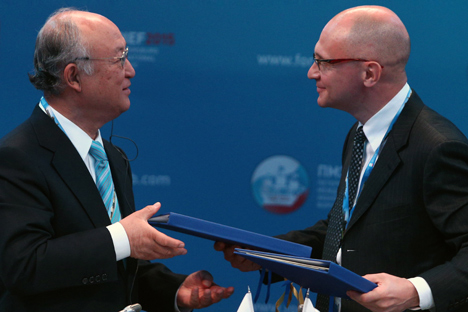
Yukiya Amano (L), Director General at International Atomic Energy Agency (IAEA), and Sergei Kiriyenko, Chief Executive Officer at the State Atomic Energy Corporation Rosatom. Source: Stanislav Krasilnikov / TASS
The World Nuclear Association (WNA) held a symposium in London on Sept. 10-12 attended by representatives of nuclear corporations, government officials and experts. The representatives discussed global partnerships in the nuclear energy sector and latest developments in the industry.
While Russia and the West are opposing each other with sanctions and counter-sanctions, nuclear co-operation is continuing without change. “Neither Rosatom nor its collaborators are on the United States and European Union sanctions list,” says Rosatom’s first deputy general director Kirill Komarov.
He adds: “It is important for everyone to understand that nuclear energy is possibly one of the few sectors of co-operation between Russia, the EU and the U.S. where before introducing some type of restriction you must think twice. Because any such move can have an impact on security.”
Indeed, the nuclear market is global and large players such as Russia, the U.S., France and the UK in the West, and South Korea, Japan, China and India in the East, are building new nuclear plants at home and in other countries. Ten years are needed to build a nuclear power station. Its operating period is about 60 years and it’s possible to extend its life by another three decades. Then between 10 and 20 years will be required to decommission a disused nuclear plant. Thus it must spend a century under the reliable control of its operators and supervising agents. The plant must also be supplied with quality fuel and be decommissioned without any incidents. That is why stable and reliable partnerships between countries throughout the entire nuclear-fuel cycle are so important in the sector.
Russia and the U.S. have collaborated for more than 20 years in the “Megatons to Megawatts” program on producing highly enriched uranium (HEU), despite changes of government. Now one in 10 American homes are supplied with power thanks to Russian uranium.
Participants at the symposium were unanimous about one thing: the security of nuclear power plants must not depend on political decisions. However, a political scenario is developing in Europe in which nuclear security has become a bargaining chip: the Ukrainian government is trying to change the nuclear fuel supplier for its plants. But despite the differences of opinion between Kiev and Moscow, Rosatom continues to supply Ukraine with fuel. “Ukraine is still ordering fuel and pays for it, and we continue to supply it. We do not have conflicts, scandals, or disruptions in supply,” said Komarov.
In the past 10 years, Rosatom has become a global corporation. It has increased its 10-year portfolio of foreign orders to more than $100bn and continues signing new contracts, many in Europe, Africa and Asia. The company is building nine nuclear power plants in Russia and a total of 29 abroad. Among Rosatom’s main European partners are the major companies Siemens, Alstom, Schneider Electric and Areva. Of all Rosatom’s foreign nuclear projects, the Fennovoima plant in Hanhikivi, Finland, which Rosatom owns and that will be built according to Russian design, stands out. The completely new plant was selected for construction by Finland’s STUK, which is regarded as the world’s strictest nuclear authority.
Komarov pointed out that the Hanhikivi plant’s electricity price for European Union consumers of about $65-70 per MW was convenient for the corporation. “We can adapt to these prices and possibly even to lower ones,” he underlined, explaining that the fuel component in the nuclear power plant’s general price was relatively low.
“The share of uranium in the total cost of a nuclear power plant is 3pc, while in gas and coal plants it is 60-70 percent,’’ notes the independent nuclear sector expert Alexander Uvarov.
The world’s interest in nuclear technologies in recent years has significantly increased. According to the forecast announced during the symposium, in the coming decades about 1,000GW of new power capacity will be introduced throughout the world, which is equal to 1,000 new nuclear power plants. The expansion of the nuclear technologies market will increase the demand for uranium, which will inevitably influence its price, which today is very low. “Prices for uranium will inevitably keep growing,’’ says Komarov. According to the WNA, the demand for uranium deposits, which are necessary for the functioning of nuclear reactors in the plants, will grow by 66 percent by 2035.
All rights reserved by Rossiyskaya Gazeta.
Subscribe
to our newsletter!
Get the week's best stories straight to your inbox